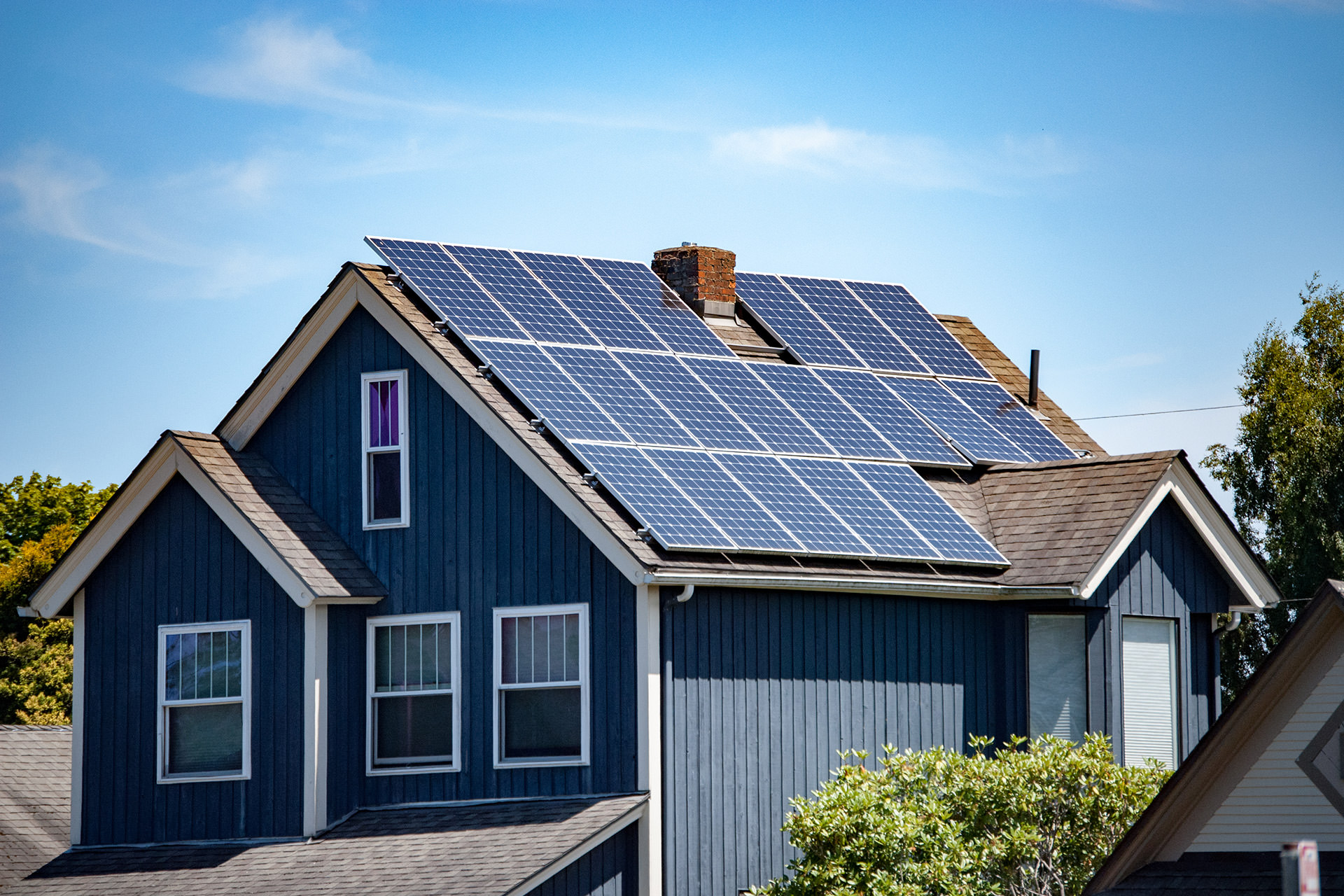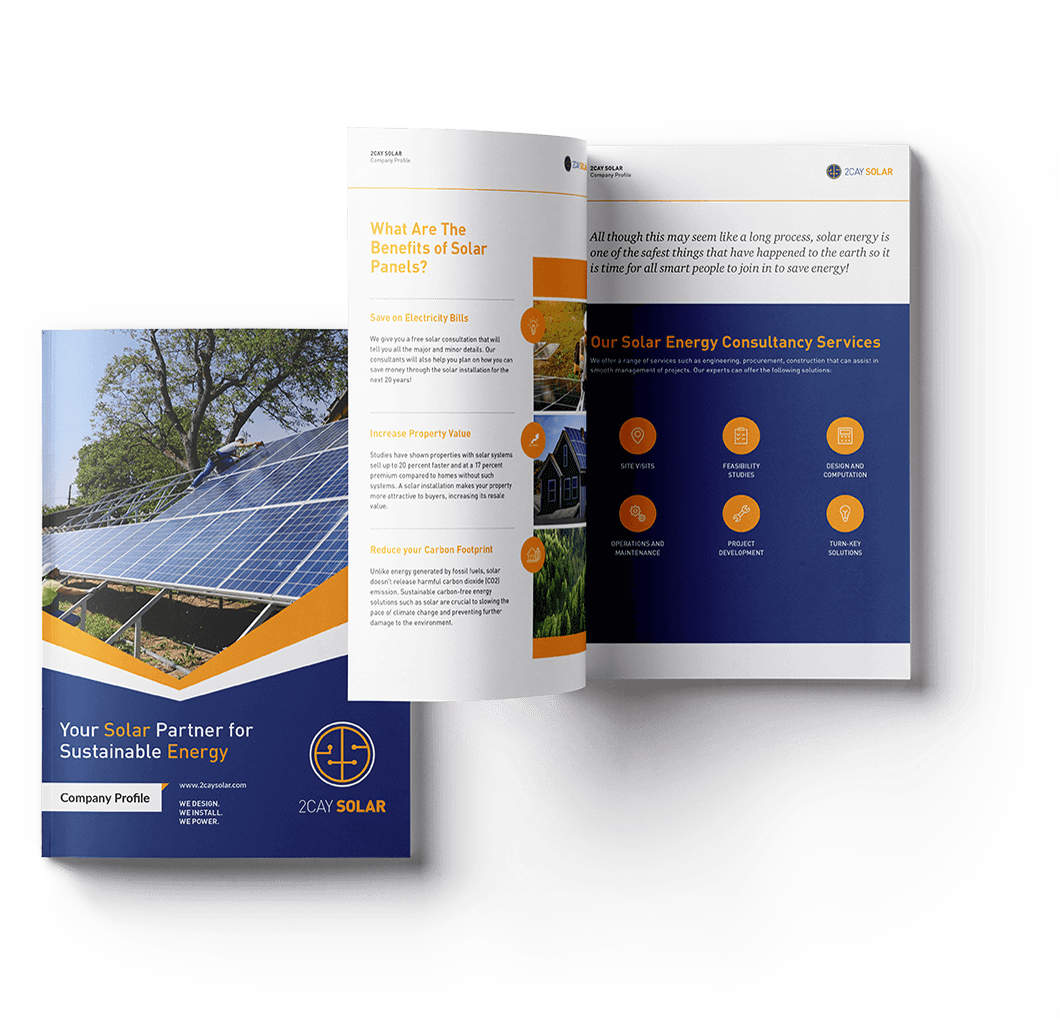Featured Solar Packages
(Prices updated as of November 16, 2019)
Computed at ₱11.50 per kWhr (Tax Included)
570W Grid-Tied Package
- 570W JA Solar Poly Duo Max Solar Panels
- 700W SOLIS Inverter
- 68kWhr Monthly Consumption
- ₱800 Average Monthly Savings
- Covered Appliance (1) 0.5hp Aircon and (1) LCD/LED TV or (1) Refrigerator, (1) LCD/LED TV, Electric Fans, Lights
680W Grid-Tied Package
- 680W JA Solar Poly Duo Max Solar Panels
- 700W SOLIS Inverter
- 80kWhr Monthly Consumption
- ₱950 Average Monthly Savings
- Covered Appliance (1) 0.75hp Aircon or (1) Refrigerator, (2) LCD/LED TV, Electric Fans, Lights
1.02KW Grid-Tied Package
- 1.02KW JA Solar Poly Duo Max Solar Panels
- 1.0KW SOLIS Inverter
- 120kWhr Monthly Consumption
- ₱1,400 Average Monthly Savings
- Covered Appliance (1) 1.0hp Aircon and Lights or (1) Washing Machine (1) Refrigerator, (2) LCD/LED TV, Electric Fans, Lights
1.7kW Grid-Tied Package
- 1.7KW JA Solar Poly Duo Max Solar Panels
- 1.5KW SOLIS Inverter
- 198kWhr Monthly Consumption
- ₱2,300 Average Monthly Savings
- Covered Appliance (1) 1.0hp Aircon, (1) Washing Machine, Electric Fans, Lights or (1) Washing Machine, (2) Refrigerator, (2) LCD/LED TV, Electric Fans, Lights
2.04kW Grid-Tied Package
- 2.04KW JA Solar Poly Duo Max Solar Panels
- 2.0KW SOLAX Inverter
- 240kWhr Monthly Consumption
- ₱2,800 Average Monthly Savings
- Covered Appliance (1) 1.5hp Aircon, (1) Refrigerator, (1) LCD/LED TV, Electric Fans, Lights
2.2kW Grid-Tied Package
- 2.2KW REC Solar Mono Solar Panels
- 2.0KW SOLAX Inverter
- 264kWhr Monthly Consumption
- ₱3,000 Average Monthly Savings
- Covered Appliance (1) 1.5hp Aircon, (1) Washing Machine, (1) Refrigerator, (1) LCD/LED TV, Electric Fans, Lights
3.4kW Grid-Tied Package
- 3.4KW JA Solar Poly Duo Max Solar Panels
- 3.0KW SOLIS Inverter
- 400kWhr Monthly Consumption
- ₱4,560 Average Monthly Savings
- Covered Appliance (2) 1.5hp Aircon, (1) Washing Machine, (1) Refrigerator, (2) LCD/LED TV, Electric Fans, Lights
4.08kW Grid-Tied Package
- 4.08KW JA Solar Poly Duo Max Solar Panels
- 5.0KW SOLIS Inverter
- 485kWhr Monthly Consumption
- ₱5,550 Average Monthly Savings
- Covered Appliance (2) 1.5hp Aircon, (1) Washing Machine, (2) Refrigerator, (3) LCD/LED TV, Electric Fans, Lights
5.44kW Grid-Tied Package
- 5.44KW Trina Polycrystalline Solar Panels
- 5.0KW SOLIS Inverter
- 635kWhr Monthly Consumption
- ₱7,300 Average Monthly Savings
- Covered Appliance (1) 2.5hp Aircon, (2) 1.5hp Aircon, (1) Washing Machine, (2) Refrigerator, (3) LCD/LED TV, Electric Fans, Lights
All packages includes: Railings with Bracket Set, DC Twin Cable (PV Cable), Suntree Protection Kit, Design and Installation
570W Grid-Tied Package
- 570W JA Solar Poly Duo Max Solar Panels
- 700W SOLIS Inverter
- 68kWhr Monthly Consumption
- ₱800 Average Monthly Savings
- Covered Appliance (1) 0.5hp Aircon and (1) LCD/LED TV or (1) Refrigerator, (1) LCD/LED TV, Electric Fans, Lights
2.2kW Grid-Tied Package
- 2.2KW REC Solar Mono Solar Panels
- 2.0KW SOLAX Inverter
- 264kWhr Monthly Consumption
- ₱3,000 Average Monthly Savings
- Covered Appliance (1) 1.5hp Aircon, (1) Washing Machine, (1) Refrigerator, (1) LCD/LED TV, Electric Fans, Lights
3.4kW Grid-Tied Package
- 3.4KW JA Solar Poly Duo Max Solar Panels
- 3.0KW SOLIS Inverter
- 400kWhr Monthly Consumption
- ₱4,560 Average Monthly Savings
- Covered Appliance (2) 1.5hp Aircon, (1) Washing Machine, (1) Refrigerator, (2) LCD/LED TV, Electric Fans, Lights
5.44kW Grid-Tied Package
- 5.44KW Trina Polycrystalline Solar Panels
- 5.0KW SOLIS Inverter
- 635kWhr Monthly Consumption
- ₱7,300 Average Monthly Savings
- Covered Appliance (1) 2.5hp Aircon, (2) 1.5hp Aircon, (1) Washing Machine, (2) Refrigerator, (3) LCD/LED TV, Electric Fans, Lights
*Solis 4G 1KW Inverter with Limiter **Solis 4G 3KW Inverter with Limiter ***Solis 4G 5KW Inverter with Limiter
All packages includes: Railings with Bracket Set, DC Twin Cable (PV Cable), Suntree Protection Kit, Design and Installation
Ready to meet your designer?
Get in touch for a free consultation.
Our Solar Energy Consultancy Services
We offer a range of services such as engineering, procurement, construction that can assist in smooth management of projects. Our experts can offer the following solutions:
SITE VISITS
FEASIBILITY STUDIES
DESIGN AND COMPUTATION
OPERATIONS AND MAINTENANCE
PROJECT DEVELOPMENT
TURN-KEY SOLUTIONS
Download 2cay Solar Company Profile
Download our company profile to learn more about our company, our services, brands we cater, our latest projects, benefits of having a solar in your home or office. Choose among our products, and we will tailor it according to your need and budget.

About 2cay Solar
2cay Solar is a solar power consultancy with an expertise in rooftop and ground mount PV (Photovoltaic) projects. Our main scope of work is to assist our clients to get the most economical solar solution with the correct performance guarantees and manage the process for them.
Your Solar Partner for Sustainable Energy!
2cay Solar strives to maintain a cutting-edge technology based on green energy by marketing the highest international-standard products that are backed by a 25-year warranty and outstanding technical support.
To provide our customers with state-of-the-art PV modules and systems at competitive prices, plus outstanding technical support and customer service.
Customer oriented by offering differentiated products and services and committed to delivering clean energy solutions to maintain a unique position in the market.
What Are The Benefits of Solar Panels?

Save on Electricity Bills
We give you a free solar consultation that will tell you all the major and minor details. Our consultants will also help you plan on how you can save money through the solar installation for the next 20 years!

Increase Property Value
Studies have shown properties with solar systems sell up to 20 percent faster and at a 17 percent premium compared to homes without such systems. A solar installation makes your property more attractive to buyers, increasing its resale value.

Reduce your Carbon Footprint
Unlike energy generated by fossil fuels, solar doesn’t release harmful carbon dioxide (CO2) emission. Sustainable carbon-free energy solutions such as solar are crucial to slowing the pace of climate change and preventing further damage to the environment.
How It Works
We follow this four easy steps to ensure the best for our clients.
1. Consultation
We give you a free solar consultation that will tell you all the major and minor details. Our consultants will also help you plan on how you can save money through the solar installation for the next 20 years!
2. Proposal
When our consultant is done and you are ready, we sign and agree to avoid any problems later. There are no hidden terms or conditions or fee, all is right there for you to read and sign.
3. Delivery and Installation
Our technicians will come over and start their work. From designing to installing, they will do everything whatever is required.
4. Completion
It is now time for you to turn on your new clean, affordable and renewable energy!
Request a Free Consultation
* Indicates required field
Solar Panels — Everything you need to know
Solar Panels: Harvesting the Energy from our Sun
Virtually unlimited power is available from our nearest star, the Sun. In just one hour, our planet receives more energy from the sun than the entire world uses during an entire year. Electricity-producing solar panels have only been around for the last 60 years, yet they have completely transformed how we harness solar energy
In 1839, a nineteen year-old French physicist named Alexandre-Edmond Becquerel discovered the operating principle of the solar cell, known as the photovoltaic effect. It wasn’t until 1876 that this effect materialized into a viable method of producing electricity with the work of William Grylls Adams. He discovered that by illuminating a junction between selenium and platinum, a photovoltaic effect occurs; electricity could now be produced without moving parts.
Revolutionary as they may have been, the selenium solar cells were not efficient enough to power electrical equipment. That ability occurred in 1953 when a Bell Laboratories employee Gerald Pearson had the bright idea of making a solar cell with silicon instead of selenium. The New York Times heralded the discovery as “The beginning of a new era, leading eventually to the realization of harnessing the almost limitless energy of the sun for the uses of civilization”.
Just in time for the space race, the first solar panels made their debut in the satellite industry. Vanguard I, the first solar-powered satellite celebrated its 53rd birthday this year, setting mileage records and holding the title of being the oldest artificial satellite still in orbit.
The first solar modules were only efficient enough for space applications, where the Sun’s radiation is much stronger. Eventually satellite research paved the way for Earth-based technology. The 1990’s were pivotal years for photovoltaic technology. Innovations in solar cells allowed for greater efficiency while lowering the cost of production. Germany and Japan led the way with long-term solar power incentive programs helping lower the cost to the public, and spurring the growth of a robust Photovoltaic industry in both countries.
How Solar Panels work
Photovoltaic solar modules are composed of multiple, interconnected solar cells, which effectively trap photon energy between layers of silicon wafers. Negatively charged electrons are then knocked loose from their atoms, allowing them to flow freely through the semiconductors. Separate diodes, and P-N junctions prevent reverse currents and reduce loss of power on partially shaded panels.
Since the flow of electrical current is going in one direction, like a battery, the electricity generated is called direct current (DC). Sunlight conversion rates are typically in the 5 to 18 percent range, with some laboratory experiments reaching efficiencies as high as 30 percent. Future possibilities include the development of multi-junction solar cells that are capable of harnessing a wider bandwidth of useable light. We are still considered to be in the “early” stages of solar cell technology.
Solar Panel Components
Photovoltaic solar panels are the main building block in a solar power system. Since each solar module produces a limited amount of power, installations usually consist of multiple panels, called an array. The array produces DC (direct current), which can be stored in batteries or instantly converted into AC (alternating current) required by conventional appliances.
Equipment that converts the power from DC to AC is known as a solar inverter, and they come in a few varieties, modified sine wave or pure sine wave. They are further classified based on which type of system it is to be used in, whether it is off-grid or grid interconnected. Recently the innovation of micro inverters has greatly simplified installations, and makes it easy to add on panels to an installation. Each solar module is paired with its own micro inverter, which then converts the power directly at the panel. For off grid installations the use of a charge controller is necessary to properly manage the power harvest, charge the batteries, and prevent overcharging.
The greatest innovation in charge controllers would have to be the relatively new feature called maximum power point tracking (MPPT). This innovative method of charging batteries constantly monitors peak power voltage from the array and input voltage on the batteries adjusting amperage to compensate for the fluctuations. This provides the most efficient means to manage the power harvest. The function of MPPT charge controllers is analogous to the transmission of a car, keeping your charging system in the “right gear”. Other components of the solar system would include the wiring and mounting hardware, while some installations use a tracker that changes its tilt angle and direction throughout the day.
Types of Solar Panels
Solar panels are classified into three classes: mono-crystalline (single crystal), poly-crystalline (multiple crystals), or amorphous silicon. Mono-crystalline is indicative of the continuous and unbroken sample of silicon in which the cell is manufactured from. This method uses very pure silicon grown in a complex growth process, and then sliced into wafers that compose the individual cells. This was the first method used to manufacture solar cells, and are still highly regarded for their efficiency ratios.
Poly-crystalline panels are composed of many crystallites of varying size and orientation. These multi-crystalline panels are generally less expensive and slightly less efficient than mono-crystalline modules, yet lately the difference in efficiency is very small. Like their mono-crystalline counterpart, the cells are also cut into wafers that make up the individual cells of a solar panel.
Amorphous solar panels use the non-crystalline, allotropic form of silicon, in which a thin layer of this silicon substrate is applied to the back of a plate of glass. These panels are much cheaper and less energy efficient, yet they are more versatile in how they can be used. For example, amorphous solar panels can be manufactured into long sheets of roofing material. Thin Film solar panels also fall into the amorphous category. This type of cells can be mounted on a flexible backing, making them more suited for mobile applications.
Each of the solar panel types is estimated to last at least twenty-five years. Instead of stopping production completely, electricity production will decline a little, gradually, over decades. The longevity of a solar panel refers to the number of years before the unit starts producing only 80 percent of its original power rating. The industry standard for warranties is 20 to 25 years, although it is not uncommon for panels to produce adequate power for over 30 years.
Off Grid versus Grid tied
Solar panels are used extensively in rural areas, where access to the grid is non-existent or inaccessible. These installations are called off grid (or independent, stand-alone) solar power systems, and require the use of batteries to store the energy for use at night or on long stretches of overcast weather. The energy stored in the batteries leaves the batteries as DC electricity which can power DC appliances (as in RV’s) or be converted to alternating current (AC) for use with conventional appliances. Much like running your own mini utility company, this method gives you full independence from the national grid.
You can eliminate the cost of batteries by going with a system that connects right into your home’s main junction box and use the grid as your power source at night or on long stretches of inclement weather. These installations are known as grid-tied or grid-interconnected systems. This version of solar system enables you to sell any excess power you produce back to the utility companies who have chosen to support “net metering”. Once you are signed up on a net metering program, your utility company will have a smart meter installed known as a Time of Use Meter, which will actually run backwards when you are producing excess power. It is wise to keep in mind that Grid tied systems without a battery backup, are only functional when the grid is operational. Due to anti-islanding features on grid tied inverters, which protect utility workers from working on a live line, grid-tied systems without a battery back up will not continue to produce power during a power outage regardless of whether you have sunshine or not.
Since solar panels produce DC, or direct current, they must be coupled with a solar inverter to convert the energy from DC to AC, or alternating current. In a grid tied system this can be done by a large central inverter, or each solar panel can be outfitted with its own micro inverter. Once the power is converted to alternating current and its phase is synchronized with that of the grid, it is then tied in to your main junction box, which is ultimately interconnected to the national grid.

